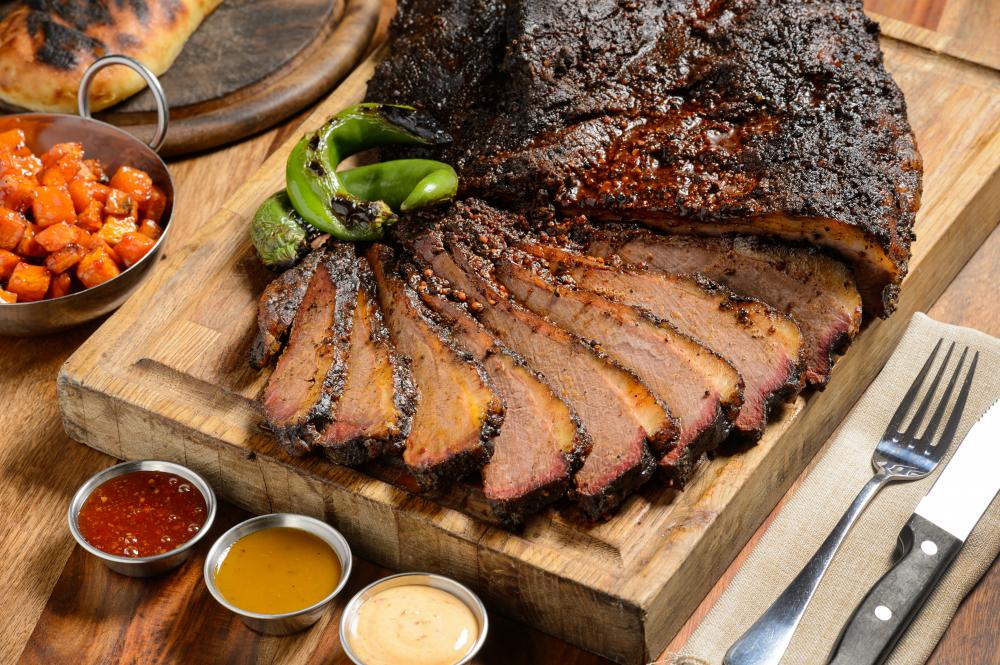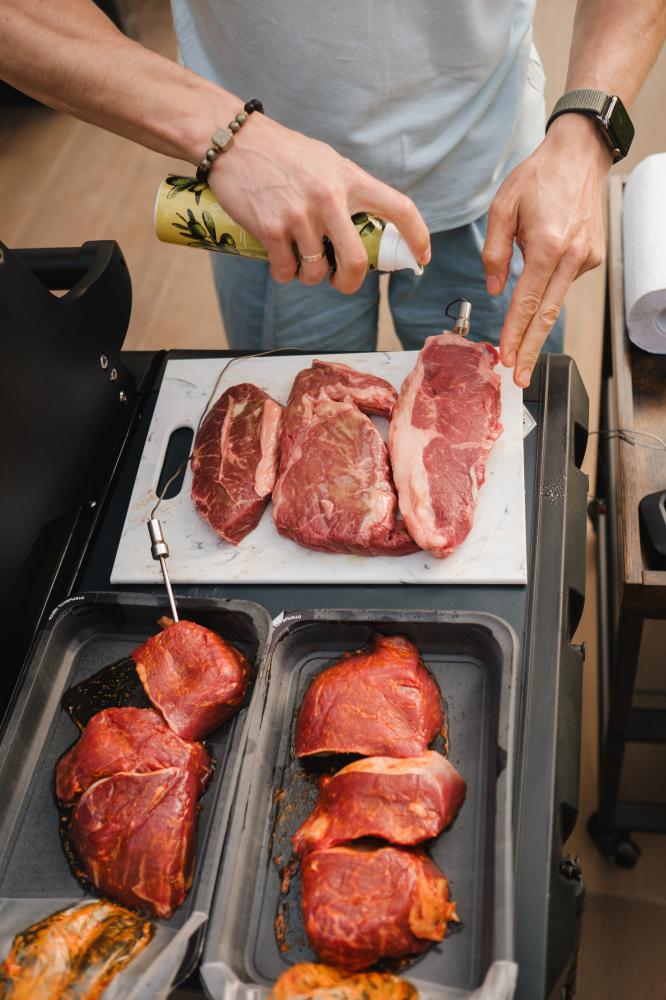
Understanding Brisket Rest Time
At Brisket Pro, we often field questions about the optimal brisket rest time. It’s a common point of contention and curiosity among both beginners and seasoned BBQ aficionados. The period after the brisket leaves the smoker but before it’s carved can dramatically influence the final result, turning a good brisket into an unforgettable one. This process, while simple in concept, involves a detailed understanding of how rest time affects the meat’s internal processes.
Why Rest Brisket?
Resting brisket is essential for a few key reasons. Firstly, it allows the meat’s juices, which have been driven to the center by the heat, to redistribute throughout the brisket. This process ensures every bite is as moist and succulent as the last. Secondly, the carry-over cooking will continue to gently finish cooking the brisket, ensuring it reaches the perfect tenderness without overdoing it.
How Long Should Brisket Rest?
The magic number for brisket rest time often lands between 1 and 2 hours. However, this is not a one-size-fits-all solution. The size of your brisket, along with the cooking conditions, can impact this timeframe. A good rule of thumb is to allow your brisket to rest until its internal temperature reduces to about 150°F. This slow cooling helps in achieving a moist, evenly cooked brisket.
Resting Techniques
There are various ways to rest brisket, each with its proponents. Some prefer resting the brisket unwrapped to preserve the bark’s crispiness, while others advocate for wrapping in butcher paper or aluminum foil to retain moisture. Wrapping can also extend the rest period without losing heat too quickly, especially useful in cooler climates or when cooking large briskets that benefit from a longer rest.
Impact on Flavor and Texture
The brisket rest time is pivotal for achieving the perfect balance of flavor and texture. Resting allows the collagen and fats within the brisket to solidify slightly, enhancing the meat’s succulence and mouthfeel. Additionally, the juices that have redistributed during this time play a critical role in amplifying the brisket’s inherent flavors, giving you that melt-in-your-mouth experience synonymous with well-cooked brisket.
Carry-Over Cooking
Understanding carry-over cooking is paramount when considering brisket rest time. Removing the brisket from the heat does not immediately halt the cooking process; the internal temperature can rise by another 5 to 10°F. This continuation can be the difference between perfection and overcooking. Thus, knowing when to pull your brisket off the heat, factoring in this carry-over effect, is essential for a tender, juicy brisket.
Tips for Success
- Use a meat thermometer to monitor the brisket’s internal temperature during and after smoking.
- Consider the environment. Cooler temperatures may require you to wrap the brisket during its rest to maintain temperature.
- Patience is key. Resist the temptation to cut into the brisket immediately and allow it the time it needs to rest fully.
- Experiment with both wrapped and unwrapped resting methods to find what works best for your taste and setup.
Common Questions
Can I rest brisket too long?
Yes, it is possible to rest a brisket for too long, especially if it’s not kept at a safe, warm temperature. Extended rest times can lead to over-softening of the bark and potential food safety concerns if the temperature falls into the danger zone (<140°F).
Should I wrap my brisket while resting?
Wrapping brisket can be beneficial, especially in maintaining moisture for longer rest periods. Whether you choose butcher paper or aluminum foil, each has unique advantages. Butcher paper is breathable, allowing some moisture escape and preserving the bark, while foil thoroughly seals, potentially softening the bark but ensuring utmost moisture retention.
Understanding and mastering brisket rest time is a game-changer in BBQ. It’s the difference between a good brisket and a great one. At Brisket Pro, we believe in sharing insights and experiences to help you achieve brisket perfection. By considering the nuances of rest time, you’re one step closer to making your brisket the highlight of any meal.

Understanding the Importance of Resting Brisket in a Cooler
Here at Brisket Pro, we understand that the journey to brisket perfection doesn’t end once it leaves the smoker. How to rest a brisket in a cooler is an art form that can elevate your barbecue to legendary status. The resting phase is critical, allowing the juices to redistribute throughout the meat, ensuring every slice is dripping with flavor. This process, often overlooked by novices, is what separates the good from the great in the world of barbecue.
Resting a brisket in a cooler serves a dual purpose. Not only does it maintain the meat at a safe temperature for consumption, but it also gives the brisket’s internal fibers time to relax and reabsorb their own juices. This makes the brisket more tender and flavorful. It’s a step that requires patience and understanding of the delicate balance between temperature and time.
Step-by-Step Guide to Resting Brisket in a Cooler
Preparation is Key
Before diving into how to rest a brisket in a cooler, let’s emphasize the importance of preparation. Ensure your cooler is clean and large enough to accommodate your brisket without cramming. Preheating your cooler by filling it with hot water then emptying it just before placing your brisket inside can help maintain the optimal temperature for resting.
The Resting Process
-
Once your brisket reaches the desired internal temperature, usually around 203°F, remove it from the smoker.
-
Wrap the brisket. Some prefer butcher paper for breathability, while others opt for aluminum foil to lock in moisture. This choice can affect the bark’s texture, so think about your preference.
-
Place the wrapped brisket in the preheated cooler. To maintain temperature, fill any empty spaces with towels. This ensures a consistent environment, mimicking a professional holding cabinet.
-
Let the brisket rest. The duration can vary, but a general rule is to allow at least 1 hour for every 10 pounds of brisket.
Checking for Doneness
Understanding when your brisket is perfectly rested is crucial. How to rest a brisket in a cooler is not just about time but also about temperature. Keep a probe thermometer handy to check that the brisket’s internal temperature doesn’t fall below 140°F. This ensures safety while maintaining the brisket’s tenderness and moisture.
Insider Tips and Tricks for Resting Brisket in a Cooler
Over the years, I’ve gathered a few tips that can make all the difference. Firstly, consider adding a temperature probe to monitor the brisket while it rests without opening the cooler constantly. This minimizes heat loss and keeps the brisket at an ideal temperature. Secondly, resting your brisket in a cooler can also soften the bark. For those who prefer a crispier bark, a quick stint under a broiler or on a grill after resting can bring back that sought-after texture.
Remember, how to rest a brisket in a cooler is not just a method but a crucial step in achieving brisket excellence. From maintaining the right temperature to preserving the brisket’s moisture and flavor, these insights have been instrumental in my barbecue journey. It’s my hope that they elevate your brisket game as well.
Lastly, don’t rush the process. The magic of a perfectly rested brisket lies in its patience during the resting phase. Letting the brisket rest allows for the culmination of flavors and textures that make each bite unforgettable.
Optimal Resting Period for Pork Butt
As experts in the art of slow cooking and smoking, we at Brisket Pro understand the nuances that go into perfecting a pork butt dish. One commonly overlooked aspect is the resting period. Determining How Long To Let Pork Butt Rest is crucial for achieving the ideal tenderness and moisture. Typically, you should allow the pork butt to rest between 1 to 2 hours. This duration allows the juices to redistribute, ensuring each bite is succulent and flavorful. It’s a sweet spot that balances practicality with culinary perfection. However, depending on your specific needs or circumstances, resting for as little as 30 minutes or up to 5 hours can still yield delicious results.
Resting Techniques for Maximum Flavor
How you rest your pork butt can have a substantial impact on the final texture and moisture of the meat. Wrapping is a debated topic among pitmasters. Some prefer to wrap the pork butt in aluminum foil or butcher paper to retain heat and moisture. This technique can push through the stall, a period during cooking where the temperature plateaus, without drying out the meat. However, if you’ve worked hard to achieve a crispy, crunchy bark, wrapping might soften it. An alternative is tenting the pork butt with aluminum foil to shield it from direct air while still allowing it to cool gradually without the bark getting soggy.
An unconventional yet effective method for resting is utilizing a cooler, often referred to as a ‘faux Cambro.’ This technique involves wrapping the pork butt in foil and placing it in a pre-heated cooler filled with towels to fill any empty space, thereby minimizing heat loss. This method can keep the pork butt at an ideal temperature for several hours, making it perfect for large gatherings or when coordinating a complex meal. Personal experience has shown that this approach not only maintains tenderness but enhances the flavors, allowing for an extended period of infusion.
Professional Insights and Experiences
In my years of smoking and cooking pork butt, I’ve tried various resting methods and times. One particular instance stands out when I let a sizable pork butt rest for close to 4 hours in a makeshift Cambro. The result was surprisingly one of the juiciest and most tender pork butts I’ve ever had. It’s anecdotes like these that underscore the importance of patience and precision in the smoking process. While traditional wisdom might suggest a shorter resting period, don’t be afraid to experiment. Each cut of meat can be unique, and sometimes, the best results come from adapting and trying new techniques.
Another insight I’ve gained is the role of ambient temperature in the resting process. During colder months, how long to let pork butt rest might slightly increase to compensate for the quicker heat loss. Conversely, in warmer weather, you might find that the meat retains its temperature longer, requiring a shorter resting period to achieve the same succulent results.
- Wrapping in foil or butcher paper: Works well to retain moisture but might soften the bark.
- Tenting: Good compromise to protect the bark while still allowing the meat to rest properly.
- Faux Cambro: Ideal for holding the meat at temperature for extended periods, ensuring it remains warm and juicy.
Remember, cooking is as much an art as it is a science. The key to perfecting How Long To Let Pork Butt Rest lies in understanding the principles behind it and then tailoring those to your specific circumstances and preferences. Whether you’re a seasoned pitmaster or a novice smoker, taking the time to rest your pork butt correctly can elevate your BBQ from good to unforgettable.

How long do you let the brisket rest?
At Brisket Pro, we recommend letting your brisket rest for a duration that compliments its size and the cooking environment it’s subjected to. Typically, the golden window falls between 1 to 2 hours. This allows the meat’s juices to redistribute uniformly, ensuring each slice is moist and flavorful. However, it’s essential to monitor the brisket’s internal temperature during this period, aiming for it to lower to about 150°F before carving.
What temperature do you take brisket off to rest?
Knowing when to pull your brisket off the heat is crucial for a perfectly rested outcome. At Brisket Pro, we suggest removing the brisket when its internal temperature reaches approximately 203°F. This temp is ideal because it accounts for carry-over cooking, where the brisket will continue to cook internally, raising another 5 to 10°F. Letting it rest afterwards ensures it doesn’t overcook, maintaining that tender, juicy texture we all love.
How long does Aaron Franklin rest his brisket?
Aaron Franklin, one of the renowned names in BBQ, advises resting brisket for a significant period, sometimes up to 4 hours. This extended rest time in a warmer or cooler maintains the brisket at an optimal temperature, ensuring the meat is tender, flavorful, and ready to fall apart at the touch. Emulating such a practice can transform your BBQ game, though it’s essential to find what best suits your schedule and brisket size.
Should you rest brisket in a cooler?
Resting your brisket in a cooler is a technique we vouch for, especially for large cuts or in situations where you need to hold the brisket at a serving temperature for longer periods. The cooler acts as a makeshift Cambro, keeping the brisket warm and moist until you’re ready to serve. It’s a fantastic method to ensure your brisket doesn’t cool down too quickly, preserving all those wonderful juices. Just be sure it’s wrapped properly to avoid any bark from getting soggy.
How does resting impact the flavor and texture of brisket?
Resting your brisket is not just a final step; it’s a critical component that impacts the overall flavor and texture. During the rest, the fibers of the meat relax, allowing the juices to reabsorb and distribute more evenly. This not only enhances the succulence but also intensifies the meat’s flavor, making each bite uniformly delicious. The rested brisket showcases a balance between a tender, melt-in-your-mouth texture and a rich, profound flavor profile that’s hard to achieve without proper rest.
Consider experimenting with both wrapped and unwrapped methods to see which yields the best results for your preference. What tips or methods have you found most effective for resting brisket? Share your experiences or questions with us; we’re always eager to learn and share more about the art of BBQ.
Resources
- USDA Food Safety and Inspection Service – Focus on Brisket – Explore information on brisket preparation and food safety guidelines from the USDA.
- Beef. It’s What’s For Dinner – Brisket – Learn more about brisket cuts, cooking techniques, and recipes from the Beef Checkoff program.
- Serious Eats – Guide to Smoker Temperatures – Discover insights and tips on maintaining the ideal smoker temperatures for cooking brisket and other meats.
- Pork Checkoff – Pork Shoulder Butt – Find resources and recipes for cooking pork shoulder butt, including information on resting techniques.
